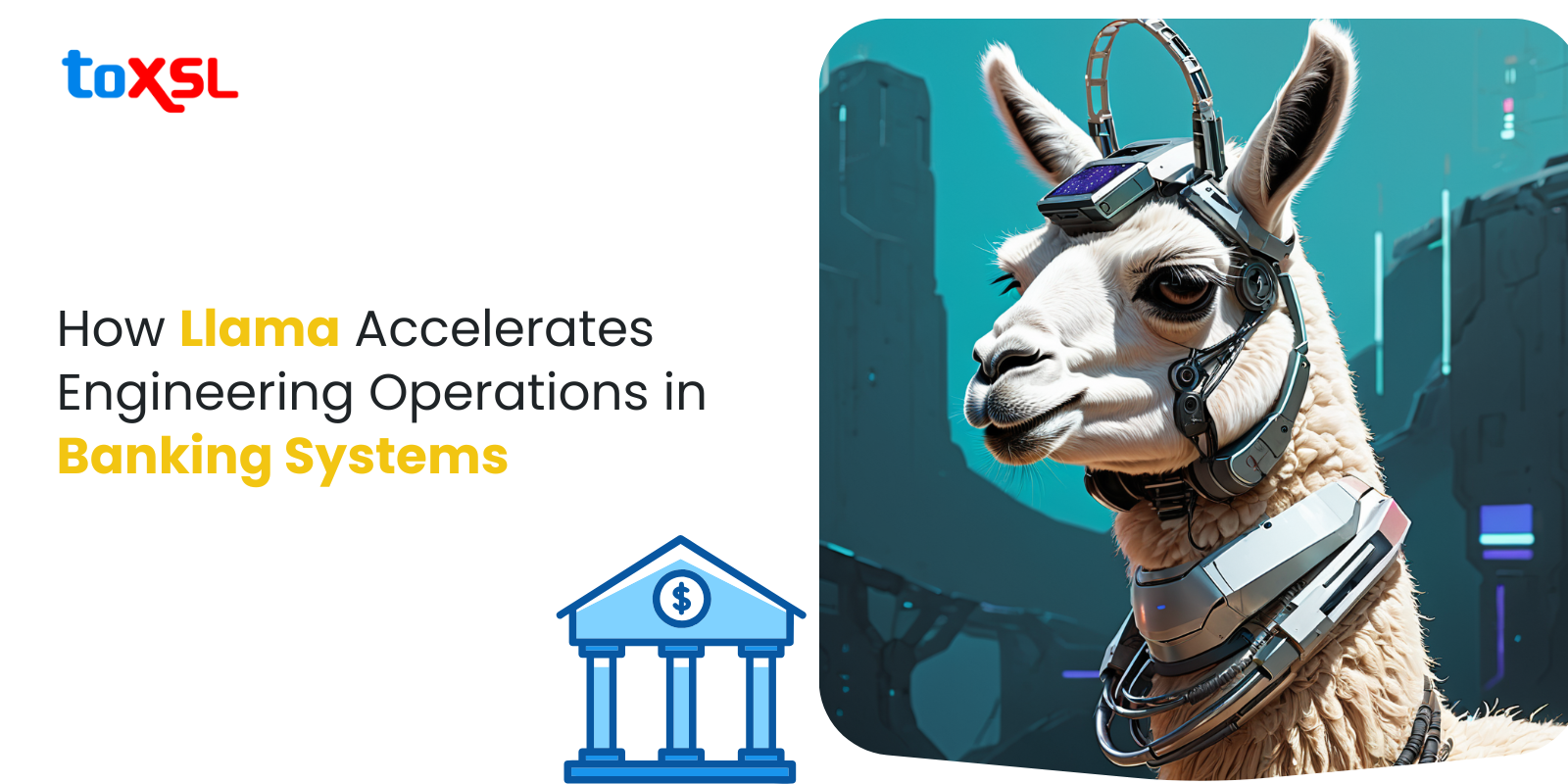- Jul 08, 2025
Share this post on:

The integration of advanced AI models like Meta’s Llama is proving transformative, particularly in accelerating engineering operations within banking systems. Large language models have opened new possibilities for Artificial Intelligence applications in finance. According to research, LLMs have the potential to improve efficiency and safety in the finance sector. Large Language Models are designed to understand, generate, and analyze human language, using natural language processing (NLP) to perform tasks including summarization, classification, and question answering. LLMs are highly effective for tasks such as content creation, sentiment analysis, and conversational AI, such as Chatbots and virtual assistants.
In finance, LLMs use complex financial documents, analyze market sentiment, and offer summaries of regulatory filings, and more. Banks and financial institutions can automate complex processes such as credit risk assessment, compliance checks, and investment analysis. They also help with fraud detection and anomaly identification by analyzing transaction patterns and flagging suspicious behavior in real-time. Fine-tuned LLMs reduce operational costs and risk while opening up new opportunities for innovation in financial products and services.
Top Financial Large Language Models (LLMs)
Let us shed some light on the top financial Large Language Models (LLMs) used in Financial Services:
FinGPT: FinGPT is an open-source financial LLM designed for tasks including sentiment analysis and can be fine-tuned swiftly to incorporate new data, making it adaptable to the dynamic nature of financial markets.
FinRoot: FinRoot is an AI agent that integrates numerous AI technologies for financial applications. It provides tools for market forecasting, document analysis, and trading strategies.
BloombergGPT: BloombergGPT is a50 billion parameter LLM trained on a lot of financial data that supports natural language processing tasks within the financial industry. It assists in improving tasks such as named entity recognition, news classification, and question answering.
InvestLM: InvestLM is an LLM fine-tuned on LlaMA-65B. The model is trained using an instruction dataset related to investment-related questions. IT is highly effective in offering financial advice and summarization.
FinLlama: FinLlama is based on the Llama 27B foundational model and is fine-tuned for financial sentiment classification, helping in algorithmic trading applications. It is highly effective in tasks that need structured reasoning and complex calculations.
Llama: An Open-Source AI Model Tailored for Banking
Meta’s Llama (Large Language Model Meta AI) stands out as a flexible, open-source AI model that banks can deploy on-premises or in the cloud, aligning perfectly with banking sector requirements for data privacy and compliance. Llama’s architecture supports:
- Fine-tuning on proprietary datasets to specialize the model for banking-specific tasks.
- Integration with existing development and debugging tools to streamline workflows.
- Advanced capabilities like retrieval-augmented generation (RAG), enabling dynamic access to structured knowledge bases.
- Agent-driven AI functionalities that automate complex decision-making processes.
This flexibility allows banks to harness generative AI’s power without compromising on security or operational control.
Practical Use Cases of Llama in Banking Engineering
API Development and Testing Automation: Banks rely heavily on APIs to connect services internally and externally. Llama’s fine-tuned models can understand API specifications, generate test cases, and even predict interactions between APIs with minimal context, accelerating development cycles and improving test coverage.
Code Generation and Review: Engineering teams benefit from Llama’s ability to generate boilerplate code, suggest optimizations, and assist in debugging, reducing the time spent on routine coding tasks and minimizing human error.
Knowledge Retrieval and Documentation: Llama acts as an intelligent assistant that retrieves relevant documentation, policy guidelines, and past incident reports, enabling engineers to quickly access critical information without manual searches.
Risk and Compliance Automation: By integrating with compliance frameworks and anonymized data, Llama supports automated checks and balances within engineering workflows, ensuring that software changes meet regulatory standards before deployment.
AI Agent-Driven Decision Support: Advanced Llama-powered agents can autonomously perform underwriting assessments, credit risk evaluations, and customer query handling, allowing engineering teams to focus on maintaining and improving these AI systems rather than manual processing.
Benefits of Llama in Banking Services
The banking industry is undergoing a profound transformation fueled by artificial intelligence (AI), with Large Language Models (LLMs) like Meta’s Llama emerging as pivotal technologies. Llama’s open-source, adaptable architecture is uniquely suited to address the complex demands of banking services, from customer engagement and risk management to compliance and operational efficiency.
1. Enhanced Customer Support and Engagement: One of the most immediate and visible benefits of Llama in banking is its ability to revolutionize customer support through intelligent, natural language interactions.
Contextual Understanding: Llama’s advanced natural language processing (NLP) capabilities enable it to understand customer queries with nuance and context, providing accurate and personalized responses across multiple channels such as chatbots, voice assistants, and messaging platforms.
24/7 Availability: Banks can deploy Llama-powered virtual assistants to offer round-the-clock support, significantly reducing wait times and improving customer satisfaction.
Multilingual Support: Llama’s language versatility allows banks to serve diverse customer bases globally without the need for extensive localization efforts.
2. Automated Loan and Credit Processing: Llama significantly optimizes the traditionally slow and manual loan and credit application processes.
Automated Application Processing: Llama can ingest and analyze loan applications, extract and verify relevant information, and assess eligibility against predefined criteria and risk models.
Contextual Onboarding: Through dynamic onboarding flows that leverage first- and third-party data, Llama simplifies and accelerates the loan application process, enhancing data validity and reducing borrower friction.
Decisions Workspace: Banks can implement user-configurable automation for underwriting and financial statement analysis, speeding up back-office operations while maintaining accuracy and profitability.
3. Improved Risk Assessment: Risk management is a cornerstone of banking, and Llama’s AI capabilities provide critical enhancements here.
Pattern Recognition: Llama excels at detecting subtle patterns in transaction data and customer behavior that may indicate fraud or financial crime.
Comprehensive Risk Analysis: By analyzing financial histories, credit scores, and behavioral data, Llama supports automated, real-time risk assessments that are more accurate and consistent than manual processes.
Anti-Money Laundering (AML): The model can cross-reference transactions against global watchlists, identify complex concealment tactics, and generate detailed Suspicious Activity Reports(SARs), strengthening compliance and reducing regulatory risk.
4. Automation of Repetitive: Behind the scenes, Llama accelerates banking engineering operations, which directly impacts service quality and innovation speed.
Code Generation and Testing: Llama can automate the generation of code snippets, API test cases, and sequence diagrams, reducing manual effort and errors.
Knowledge Management: Acting as an intelligent assistant, Llama retrieves relevant documentation, past incident reports, and policy guidelines, helping engineers resolve issues faster and make informed decisions.
AI-Powered Agents: Banks are deploying Llama-driven AI agents to autonomously handle underwriting, credit assessment, and other decision-making processes, freeing human resources for strategic work.
Conclusion:
Meta’s Llama model is revolutionizing engineering operations in banking systems by providing a flexible, secure, and powerful AI foundation. Using fine-tuning and integration, banks have demonstrated how Llama can streamline workflows, automate complex tasks, and enhance collaboration, all while adhering to the rigorous demands of the financial sector. As the banking industry moves towards an AI-driven future, Llama’s role as an enabler of efficient, compliant, and innovative engineering operations is set to grow, helping banks deliver better services faster and more securely.












